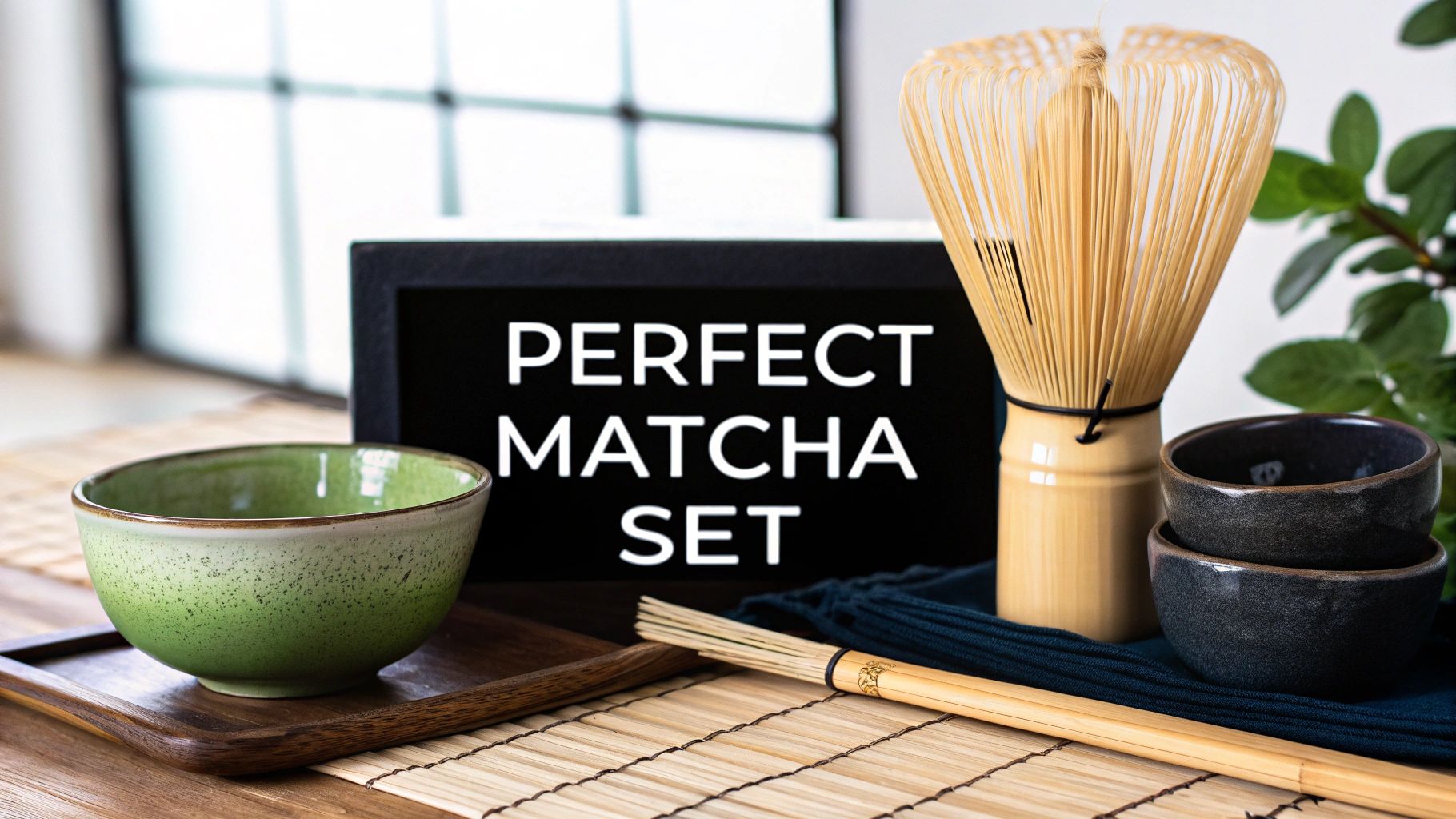At its heart, a ceremonial matcha set is a carefully chosen collection of traditional tools, the very same ones used for centuries in the Japanese tea ceremony. It brings together the essential items you need: a bamboo whisk (Chasen), a tea bowl (Chawan), and a bamboo scoop (Chashaku). Each piece is crafted to help you prepare the perfect bowl of matcha, unlocking its signature rich flavour and velvety, frothy texture.
The Gateway to a Mindful Ritual
Think of a ceremonial matcha set as more than just a few utensils; it's your invitation to a mindful ritual that has been practiced in Japan for centuries. It's a bit like an artist's toolkit. You could mix paint with a twig, but a proper brush gives you precision, texture, and control. In the same way, these traditional tools are designed to work together, transforming a fine green powder into a vibrant, frothy tea.
This practice, known as Chado or "the way of tea," is built on the principles of harmony, respect, purity, and tranquillity. When you use the set, you’re encouraged to slow down and focus on each deliberate movement—from scooping the matcha powder to whisking it into a perfect foam. It’s all about creating a moment of calm and focus in your day.
Why the Right Tools Are Essential
Every component in the set plays a specific and vital role in creating the ideal flavour and texture that define high-quality matcha. Understanding why these tools matter is the first step towards a truly authentic experience.
- Flavour and Froth: The fine, delicate tines of a bamboo whisk are uniquely suited for aerating the matcha. They create a smooth, creamy foam without leaving any clumps behind, something a metal whisk just can't replicate.
- Precision: The bamboo scoop is shaped to measure the correct amount of matcha powder, which is the key to achieving a balanced, non-bitter taste.
- Mindfulness: The simple act of using these traditional tools connects you to a rich cultural history, turning the preparation of a drink into a meaningful practice.
The rising popularity of matcha here in the UK really shows a growing interest in these kinds of wellness rituals. It's part of a wider European trend, with the matcha tea market showing steady growth. This wave is largely driven by younger generations and social media, which has done wonders for raising awareness of Japanese tea culture. For today’s UK consumer, the ceremonial matcha set isn't just a set of utensils; it's a symbol of mindfulness and tradition that really resonates. You can read more about this market growth in a detailed report on the European matcha market from Research and Markets.
Of course, to begin this journey, you'll need to pair your set with the right matcha. We recommend starting with Amatsu Matcha's Pure or Radiance blends, as they are crafted specifically for traditional preparation. Their superior quality ensures your first experience is as delicious as it is authentic. To learn more, have a look at our guide on what makes a great ceremonial grade matcha.
The Essential Tools in Your Matcha Set
Think of a ceremonial matcha set less as a collection of utensils and more as a cast of characters in a centuries-old story. Each tool has a very specific and vital role to play. They aren't just there for show; they're specialised instruments designed to work in concert, transforming the simple act of making tea into a truly mindful practice. Getting to know them is the first step in appreciating the art behind a perfect bowl of matcha.
At the very heart of the ritual is the Chawan (茶碗), or tea bowl. Its wide, open shape isn't just for looks—it's the perfect canvas for whisking. This design gives the bamboo tines of the whisk plenty of room to move, helping you aerate the matcha into that signature creamy froth. You just can't get the same result from a standard teacup, which is far too narrow.
The Instruments of Froth and Precision
Next up, we have the Chasen (茶筅), the iconic bamboo whisk. It’s a small work of art, hand-carved from a single piece of bamboo. Its delicate tines, usually numbering between 80 and 120, are engineered to suspend the fine matcha powder in water. This is what creates that rich, velvety foam—a feat a metal spoon or an electric frother can't replicate, as they just create large, coarse bubbles instead of a delicate microfoam.
To measure out your matcha powder, you’ll use the Chashaku (茶杓). This is a slender bamboo scoop designed for consistency, ensuring your tea’s flavour is perfectly balanced and not overly bitter. As a rule of thumb, one to two scoops are used per bowl, making it a true instrument of precision in the pursuit of the perfect taste.
This image gives you a fantastic visual overview of these essential tools.
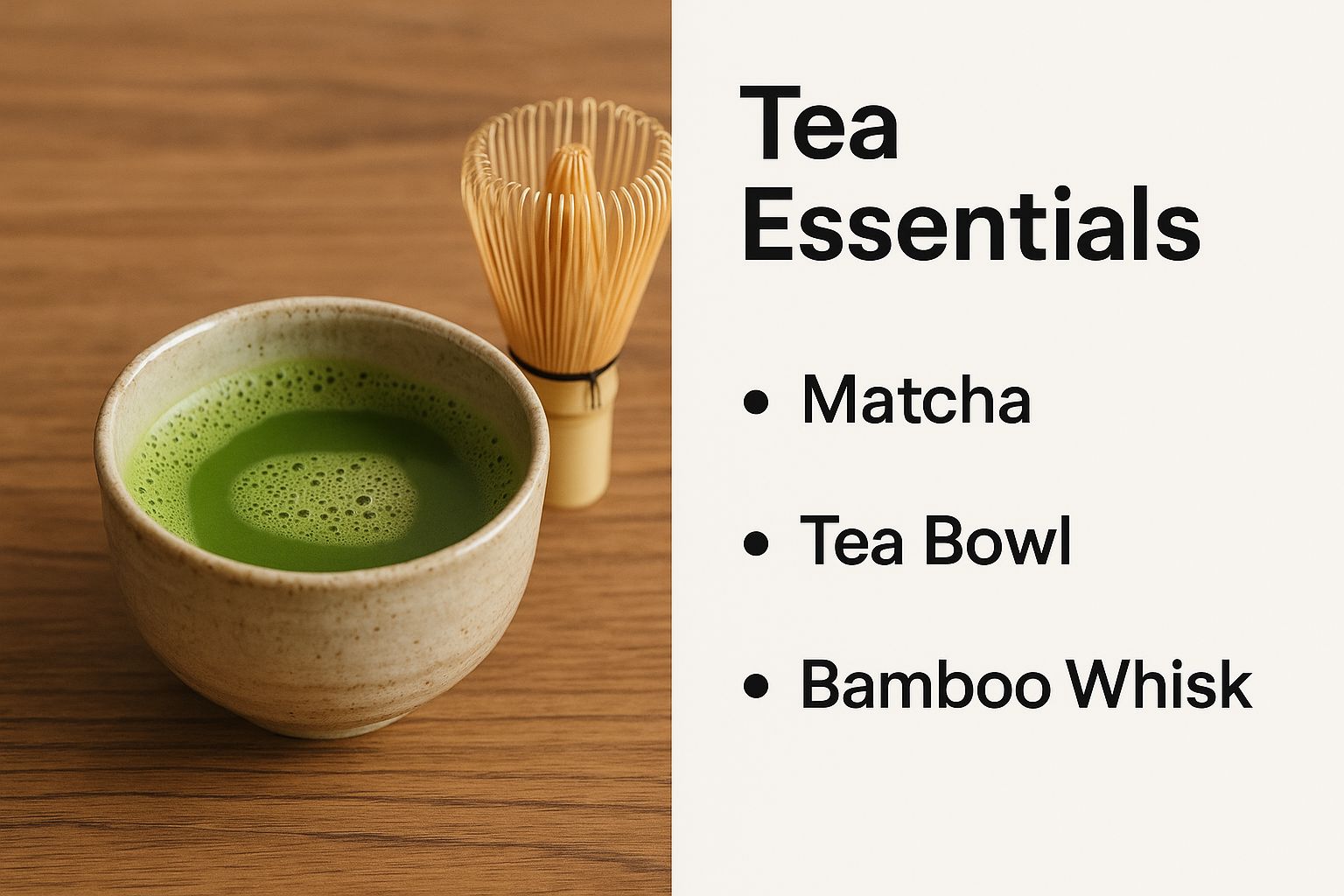
As you can see, there’s an elegant simplicity to how form and function come together. Each piece is crafted not just for its practical job but also to add to the serene, focused atmosphere of the ritual itself.
To help you get familiar with these items, here's a quick summary of the key components you'll find in a ceremonial matcha set.
Key Components of Your Ceremonial Matcha Set
| Tool Name (English) | Japanese Name | Primary Function | Material |
|---|---|---|---|
| Tea Bowl | Chawan | Provides the ideal space for whisking matcha | Ceramic |
| Bamboo Whisk | Chasen | Aerates the matcha to create a creamy froth | Bamboo |
| Bamboo Scoop | Chashaku | Measures a consistent amount of matcha powder | Bamboo |
| Whisk Holder | Kusenaoshi | Maintains the shape and integrity of the whisk | Ceramic/Porcelain |
This table neatly lays out the core four instruments that will become your companions on your matcha journey.
Preserving Your Tools for Longevity
Finally, a complete set will almost always include a Kusenaoshi (くせ直し), or whisk holder. This ceramic piece might look like an afterthought, but it's the secret to keeping your Chasen in prime condition for years to come.
After rinsing, resting the delicate bamboo whisk on a Kusenaoshi allows its tines to air-dry properly while maintaining their elegant, curved shape. This simple step stops the tips from becoming brittle and breaking over time, preserving the tool's effectiveness for countless bowls of matcha.
If you just leave your whisk to dry on its side, the tines can close inward or lose their shape, which makes it much harder to whip up a good froth next time. This small act of care is a way of honouring the craftsmanship of the tools and ensuring every bowl of matcha you make is as good as the first.
The beautiful way these tools work together is a massive part of the experience. You can dive deeper into the history and meaning behind the Japanese tea ceremony matcha in our detailed guide. Together, these components are more than just items; they are your complete kit for embracing a moment of calm and focus.
How to Choose the Right Ceremonial Matcha Set
Choosing your first ceremonial matcha set is a genuinely exciting moment. It’s your entry into a world of mindful ritual and incredible flavour. But when you start looking, the options can feel a bit overwhelming—from simple starter kits to stunning artisan collections. So, where do you begin? The secret is to think about quality, craftsmanship, and what feels right for you and your journey.
Think of it like buying your first really good kitchen knife. A well-made one just feels right in your hand, performs flawlessly, and makes the whole process of cooking a joy. It’s the same with a matcha set. The right tools don't just get the job done; they elevate the entire ritual and genuinely improve the taste of your tea. You're not just buying objects; you're investing in an experience.
Balancing Quality and Budget
When you're just starting, finding that sweet spot between quality and price is key. A good beginner's ceremonial matcha set should give you all the essentials, beautifully made, but without a price tag that makes you nervous. This way, you can dive into learning the art of preparation without worrying about a huge initial spend. The focus should be on the practice, not the price.
On the other hand, if you're already devoted to your daily matcha moment, upgrading to an artisan-crafted set can be a wonderful next step. These sets often feature unique, handmade bowls and whisks that are the product of generations of skill, adding a whole new layer of appreciation to your routine.
What to Look for in Each Component
To choose wisely, you need to know what makes each tool special. The quality of the individual pieces really does dictate the quality of your whole matcha experience.
- The Chawan (Bowl): You’ll want a bowl made from lead-free, food-safe ceramic. The most important feature is its wide, flat bottom—this gives you the space you need to whisk properly and build that perfect, creamy froth.
- The Chasen (Whisk): A proper chasen is carved from a single piece of bamboo. Look for one with around 80-100 tines. This count is ideal for beginners because it makes whipping up a smooth, consistent foam much, much easier.
- The Chashaku (Scoop): This delicate scoop should also be made from bamboo. Its gentle curve is specifically designed to measure out the perfect amount of matcha powder without creating any static cling.
A well-chosen ceremonial matcha set is more than just a purchase; it's a companion for your wellness journey. The quality of the bamboo, the feel of the glaze on the bowl, and the balance of each tool—it all comes together to turn a simple daily habit into a profound, calming ritual.
The rising interest in these traditions is clear. In the UK alone, the matcha tea market was valued at about USD 340 million in 2025 and is expected to soar to USD 790 million by 2031. This isn't just a trend; it's a reflection of a wider shift towards wellness and mindfulness, which is why you're seeing ceremonial sets in more and more homes, cafes, and wellness centres. You can dig into more data on the UK's growing matcha market from Mobility Foresights.
Here at Amatsu Matcha, we’ve put a lot of thought into curating our sets. Each one meets our high standards for both authenticity and craftsmanship, making them a choice you can trust. Once you have your tools, pairing them with the right powder is the final step to a perfect cup. For a little more help on that front, have a look at our guide on how to select the best ceremonial grade matcha.
Preparing a Perfect Bowl of Ceremonial Matcha
With your beautiful ceremonial matcha set in hand, you’re ready to create a moment of pure, focused calm. The magic isn't in some complex recipe, but in a series of simple, meaningful steps. This is where the tools truly come to life, transforming fine powder and warm water into a vibrant, frothy elixir.
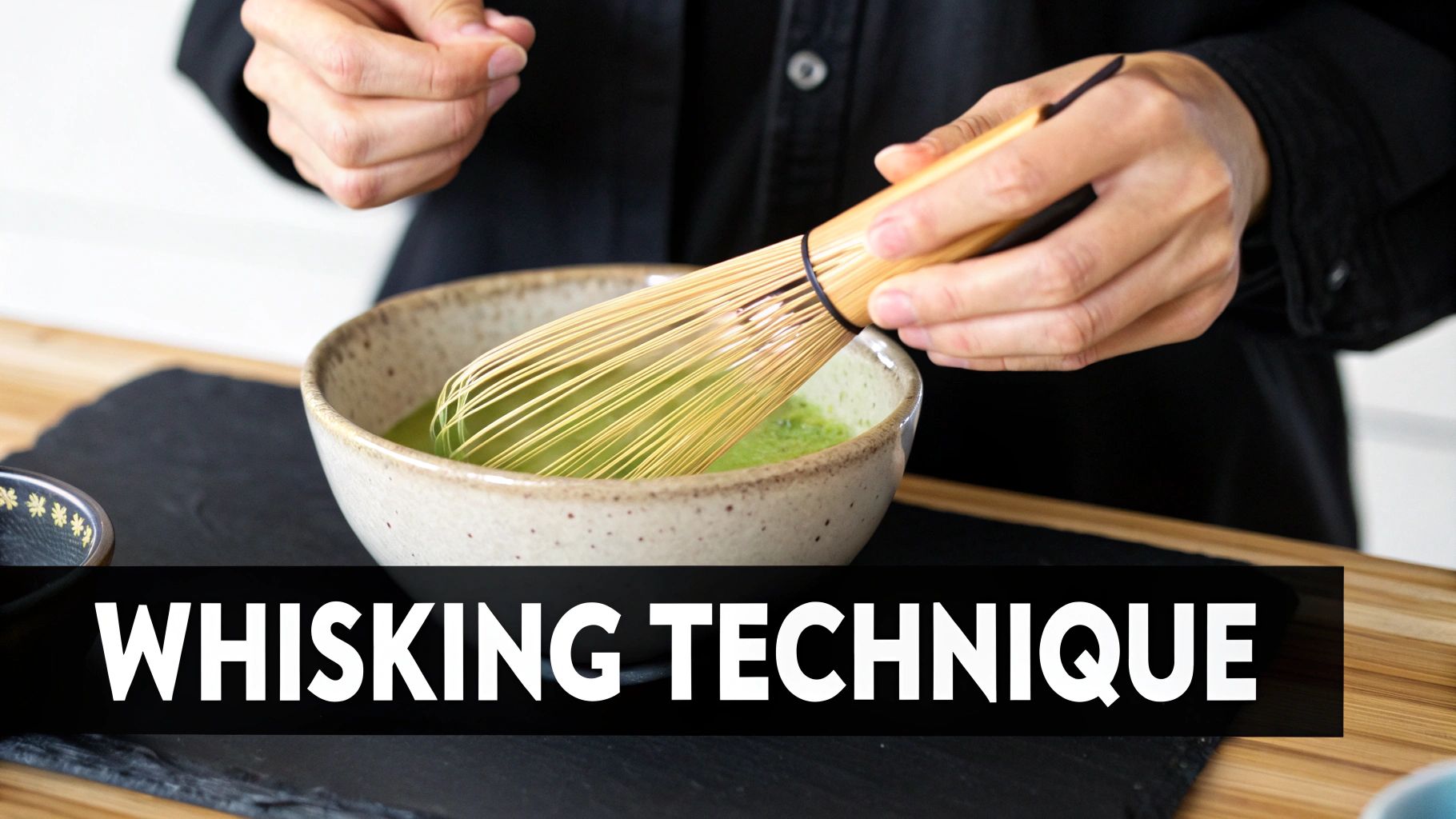
Interestingly, the process begins not with the tea, but with the bowl. Start by pouring a little hot water into your Chawan (tea bowl) to gently warm the ceramic. It’s a small act, but it makes a big difference, ensuring your matcha stays at the perfect temperature. While the bowl warms up, soak the tines of your Chasen (bamboo whisk) in the same water. This makes them soft, pliable, and much less likely to snap.
After a minute, tip the water out and dry the bowl thoroughly. Now, you’re ready for the matcha itself.
The Art of Sifting and Whisking
Using your Chashaku (bamboo scoop), measure one to two scoops of high-quality ceremonial grade matcha powder into the bowl. Sifting the powder through a small sieve is a step you should never skip. It breaks up any tiny clumps and is your ticket to a silky-smooth texture, completely free from any grittiness.
Next, add about 60-70 ml of hot water. The key here is hot, not boiling. The ideal temperature is around 80°C (175°F). If the water is too hot, it will scorch the delicate tea leaves, leaving you with a bitter, unpleasant flavour.
Now for the most iconic part of the whole ritual: whisking. Hold the Chawan firmly with one hand and, with a relaxed wrist, begin to move your Chasen through the mixture. The secret is to use a swift 'W' or 'M' shaped pattern, not a circular stirring motion. Your goal is to create a vibrant, jade-green liquid topped with a blanket of fine, creamy foam.
A perfect bowl of matcha is a full sensory experience. You’re looking for a uniform froth with tiny, champagne-like bubbles. The aroma should be fresh and grassy, and the colour a brilliant green—all signs that your technique and ingredients are perfectly aligned.
The quality of the powder is absolutely paramount to this entire experience. Here in the UK, there's a strong preference for the traditional way of making matcha. In fact, market data shows that matcha in its loose powder form accounts for over 55% of the UK market's revenue. This really highlights a clear demand for the authentic taste that only comes from using proper ceremonial-grade powder and a good ceremonial matcha set.
Your Step-by-Step Preparation Guide
To make it even simpler, here’s the process broken down:
- Warm the Tools: Pour hot water into the Chawan to warm it, and soak the Chasen tines at the same time.
- Measure and Sift: Discard the water, dry the bowl, and sift 1-2 scoops of matcha powder directly into it.
- Add Hot Water: Gently pour 60-70 ml of 80°C water over the sifted powder.
- Whisk Vigorously: Using a rapid 'W' or 'M' motion, whisk until a thick, uniform froth forms on the surface.
- Enjoy Immediately: Once frothed, your matcha is ready. Drink it straight from the bowl to savour its full, rich flavour and aroma.
This ritual is simple to master, and each step offers a wonderful moment of mindfulness. To unlock the full potential of your matcha, we recommend using Amatsu's Pure for a classic, smooth flavour or Radiance for an added wellness boost.
Caring for Your Artisan Matcha Tools
Your ceremonial matcha set is more than just a collection of tools; it's an investment in a beautiful, mindful practice. Each piece is crafted by artisans from natural materials, and with the right care, they can genuinely last a lifetime. Treating them with respect not only preserves their quality but also honours the tradition they represent, helping you prepare the perfect bowl of matcha every single time.
Proper care is surprisingly simple and only takes a few moments after each use. Think of it as the final, calming step in your ritual. The golden rule is to be gentle and steer clear of harsh chemicals or extreme temperatures, which can easily damage the delicate bamboo and ceramic.
Maintaining Your Bamboo Whisk and Scoop
The Chasen (bamboo whisk) is probably the most delicate part of your set, so it needs a bit of special attention. As soon as you've finished whisking, rinse it immediately under a gentle stream of warm water. Never, ever use soap on it. The bamboo is porous and can absorb the soap's flavour, which will definitely ruin your next cup of tea.
After rinsing, give it a gentle shake to get rid of any excess water. The next step is the most important one for its longevity: place it, tines pointing down, onto its Kusenaoshi (whisk holder).
The Kusenaoshi is the Chasen's best friend. It allows the delicate bamboo tines to dry evenly, but more importantly, it helps them maintain their elegant, curved shape. Without it, the tines can become brittle, lose their form, or even develop mould, which completely ruins the whisk's ability to create that perfect froth.
The Chashaku (bamboo scoop) is much simpler to look after. Just wipe it clean with a soft, dry cloth. Try to avoid getting it wet, as too much moisture can cause the bamboo to warp or split over time. A quick, gentle wipe is all it needs.
If you'd like to learn more about this crucial tool, you can dive into our complete guide to the matcha green tea bamboo whisk.
Cleaning and Storing Your Chawan
Your Chawan (tea bowl), while more robust, still appreciates gentle handling. Once you’ve finished your matcha, simply rinse the bowl with warm water and wash it by hand. It's best to avoid the dishwasher; the high heat and harsh detergents can damage the beautiful glaze over the years. A soft cloth or sponge is perfect.
Proper storage is the final piece of the puzzle. Keep all your tools in a cool, dry place, well away from direct sunlight. This stops the bamboo from becoming brittle and protects the ceramic glaze from fading, ensuring your set stays beautiful and functional for many years of mindful tea preparation to come.
Turning Your Daily Brew into a Mindful Ritual
Once you’ve got the hang of the basic steps, your ceremonial matcha set stops being just a collection of tools and starts becoming part of a deeper daily practice. This is where you elevate the simple act of making tea into a genuine ritual—a cherished moment of peace and focus in your day.
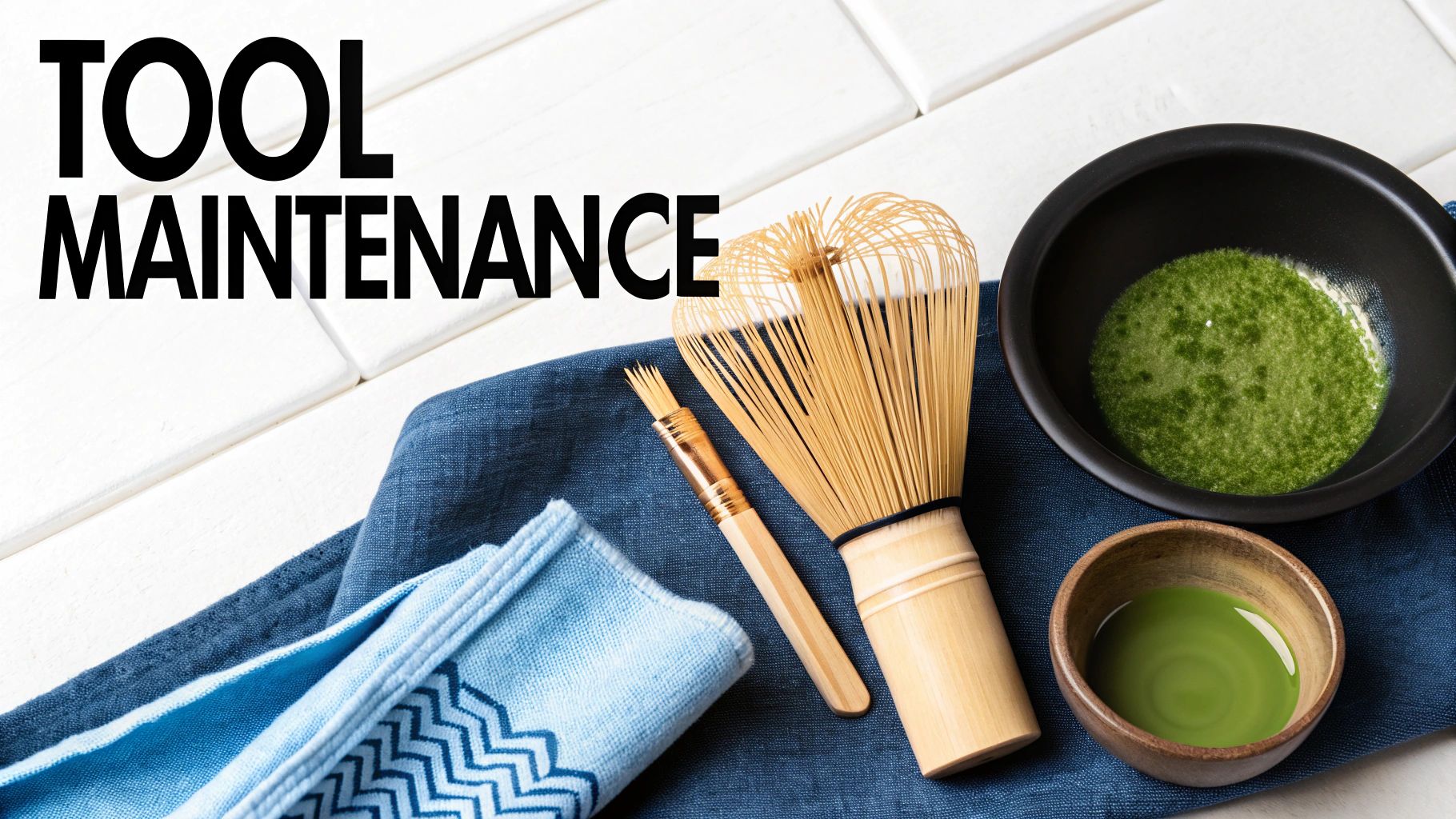
It all starts with your surroundings. Find a quiet, uncluttered spot where you won’t be disturbed. Just by setting the stage, you're signalling to your mind that it’s time to slow down and shift gears, leaving the day's hustle behind.
From there, it’s all about engaging your senses. This is where the ceremonial matcha set really shines. Notice the comforting warmth of the Chawan cradled in your hands. Listen to the gentle sound of the Chasen whisking against the bowl. And of course, breathe in that fresh, grassy aroma as the hot water makes the matcha bloom.
Making the Ritual Your Own
Your daily ritual doesn't need to be rigid or follow a strict formula. A wonderful way to personalise the experience is to explore different matcha blends, each one created to support a different aspect of your well-being.
Think about matching your matcha choice to what you need that day:
-
For a Morning Kick-Start: Need to hit the ground running? Begin your day with a blend designed for energy and focus. The Strength or Shrooms blends from Amatsu Matcha are brilliant for this, giving you a clean, sustained lift without the crash of coffee.
-
For a Moment of Calm: If you’re winding down in the evening or seeking a self-care moment, a different blend is in order. Our Radiance blend, with added marine collagen and hyaluronic acid, is a perfect companion for nourishing your body from the inside out.
By mindfully choosing your blend, making matcha becomes more than just a habit—it becomes a purposeful act of self-care. It's a chance to check in with yourself and give your mind and body exactly what they’re asking for.
A Few Common Questions About Your Matcha Set
Embarking on the path of matcha is exciting, but it’s completely normal to have a few questions. The traditional tea ceremony has a lot of history behind it, and getting to grips with the details is what makes the experience so rewarding.
Think of this section as a friendly guide to answer the most common things people wonder about. We’ll clear up any confusion so you can get straight to the good part: enjoying a perfect bowl of matcha.
Practical Tips and Matcha Myths
Let's dive into some of the practical questions that pop up when you're just starting out. These answers will help you get the absolute best from your new set.
Can I just use a milk frother instead of the bamboo whisk?
You can, but you'll be missing out on what makes matcha truly special. A metal frother will mix the powder, but it can’t create the same delicate, creamy foam that a traditional Chasen (bamboo whisk) does. The whisk’s 80 to 120 natural tines are designed to suspend the tea particles perfectly in the water, creating that signature smooth froth. A frother tends to create big, airy bubbles and can even leave a faint metallic taste, altering the pure flavour of the matcha.
What’s the real difference between ceremonial and culinary matcha?
This is probably the most important thing to understand. Ceremonial grade matcha, like our Amatsu Matcha Pure blend, is made from the youngest, most delicate tea leaves picked during the year's very first harvest. This gives it that brilliant green colour and a smooth, naturally sweet flavour that’s meant to be enjoyed on its own with hot water.
Culinary grade, on the other hand, comes from later harvests. The leaves are a bit older, which results in a bolder, slightly more bitter taste that’s strong enough to shine through in lattes, smoothies, and baking. For the traditional ritual, you always want to use ceremonial grade.
At the end of the day, remember this: a ceremonial matcha set is built for ceremonial grade powder. Using the right matcha with the right tools is the secret to unlocking the rich, umami flavour and creamy texture that makes this tea so special.
How should I be cleaning my bamboo whisk?
Proper care is surprisingly simple, but it’s key to making your whisk last. Rinse your Chasen under warm running water right after you use it. Never, ever use soap, as the porous bamboo can absorb it and spoil the taste of your tea.
Just swish it around gently in the water until all the green is gone. To dry it, place it tines-down on its Kusenaoshi (whisk holder). This isn't just for looks; it helps the whisk keep its beautiful shape and prevents the delicate tines from getting mouldy.
Ready to start your own mindful ritual? Discover the perfect ceremonial matcha set and our premium matcha blends at Amatsu Matcha. You can explore our collections here and take the first step towards a calmer, more focused day.
Read more
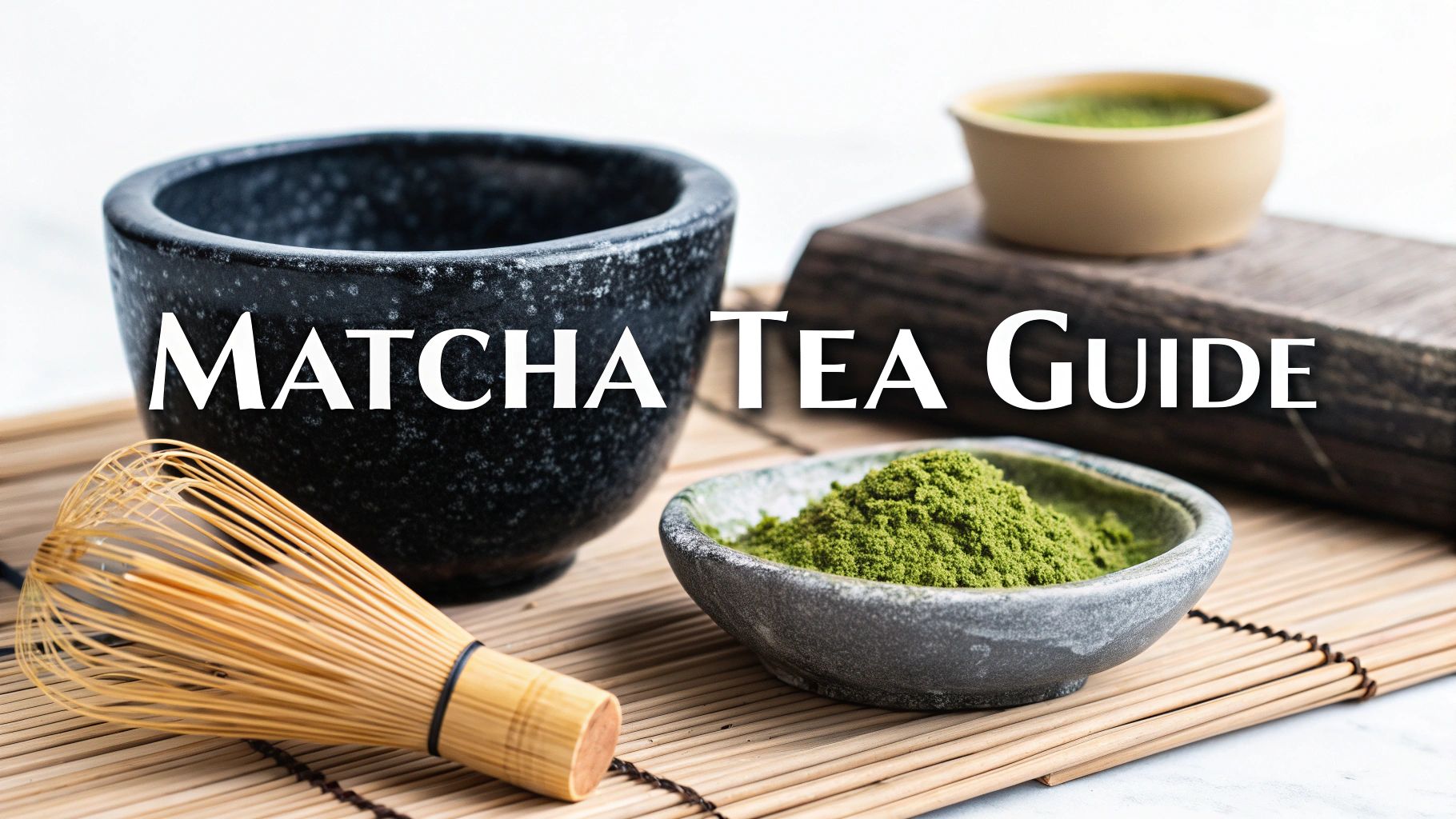
Explore our guide to authentic matcha tea from Japan. Discover its health benefits, how to choose the best grade, and the art of traditional preparation.
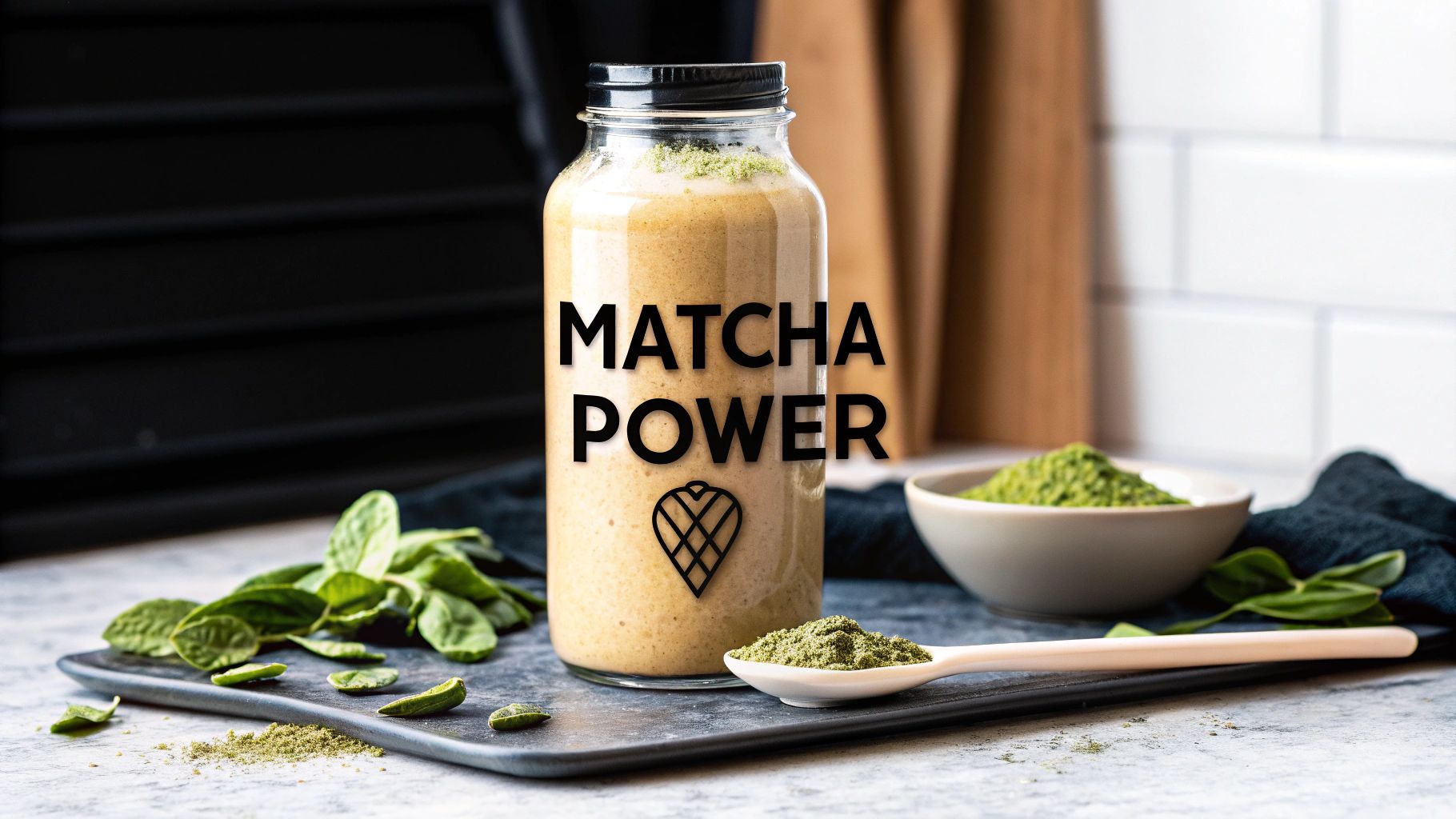
Learn to make a healthy, energy-boosting matcha green tea protein shake with our easy recipe and expert tips. Perfect for a nutritious boost!
